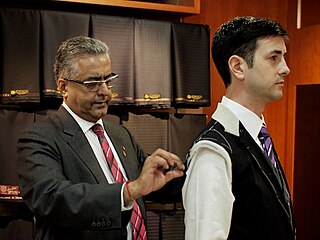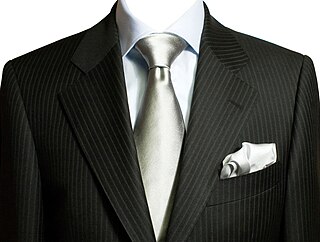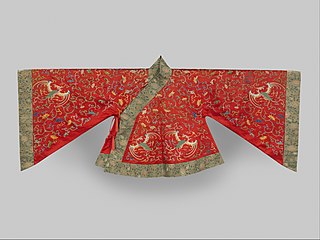
Black tie is a semi-formal Western dress code for evening events, originating in British and American conventions for attire in the 19th century. In British English, the dress code is often referred to synecdochically by its principal element for men, the dinner suit or dinner jacket. In American English the equivalent term tuxedo is common. The dinner suit is a black, midnight blue or white two- or three-piece suit, distinguished by satin or grosgrain jacket lapels and similar stripes along the outseam of the trousers. It is worn with a white dress shirt with standing or turndown collar and link cuffs, a black bow tie, typically an evening waistcoat or a cummerbund, and black patent leather dress shoes or court pumps. Accessories may include a semi-formal homburg, bowler, or boater hat. For women, an evening gown or other fashionable evening attire may be worn.

A suit, lounge suit, or business suit is a set of clothes comprising a suit jacket and trousers of identical textiles worn with a collared dress shirt, necktie, and dress shoes. It is considered informal wear in Western dress codes. The lounge suit originated in 19th-century Britain as a more casual alternative for sportswear and British country clothing, with roots in early modern Western Europe. After replacing the black frock coat in the early 20th century as regular daywear, a sober one-colored suit became known as a lounge suit.

A tailor is a person who makes or alters clothing, particularly in men's clothing. The Oxford English Dictionary dates the term to the thirteenth century.
Drape suits are a 1930s British variation of the three-piece suit, in which the cut is full and 'drapes'. It is also known as the blade cut or London cut. The design of the athletic aesthetic of the drape suit is attributed to the London tailor Frederick Scholte. The new suit cut was softer and more flexible in construction than the suits of the previous generation; extra fabric in the shoulder and armscye, light padding, a slightly nipped waist, and fuller sleeves tapered at the wrist resulted in a cut with folds, or "drapes," front and back that created the illusion of the broad-shoulders and tight-waist "V" figure of the very fit.
Clothing terminology comprises the names of individual garments and classes of garments, as well as the specialized vocabularies of the trades that have designed, manufactured, marketed and sold clothing over hundreds of years.

Buttonholes are reinforced holes in fabric that buttons pass through, allowing one piece of fabric to be secured to another. The raw edges of a buttonhole are usually finished with stitching. This may be done either by hand or by a sewing machine. Some forms of button, such as a frog, use a loop of cloth or rope instead of a buttonhole. Buttonholes can also refer to flowers worn in the lapel buttonhole of a coat or jacket, which are referred to simply as "buttonholes" or boutonnières.

A double-breasted garment is a coat, jacket, waistcoat, or dress with wide, overlapping front flaps which has on its front two symmetrical columns of buttons; by contrast, a single-breasted item has a narrow overlap and only one column of buttons.

In sewing, to tack or baste is to sew quick, temporary stitches that will later be removed. Tacking is used for a variety of reasons, such as holding a seam in place until it is sewn properly, or transferring pattern markings onto the garment. Tacking is typically sewn using a specialised tacking thread, which may snap easily in order for it to be easily removed from the garment when necessary.

Lapels are the folded flaps of cloth on the front of a jacket or coat and are most commonly found on formal clothing and suit jackets. Usually they are formed by folding over the front edges of the jacket or coat and sewing them to the collar, an extra piece of fabric around the back of the neck.

Battledress (BD), later named the No. 5 Uniform, was the combat uniform worn by British Commonwealth and Imperial forces through the Second World War.
Sweater design is a specialization of fashion design in which knitted sweaters are designed to fulfill certain aesthetic, functional and commercial criteria. The designer typically considers factors such as the insulating power of the sweater ; the fashion of its colors, patterns, silhouette and style lines, particularly the neckline and waistline; the convenience and practicality of its cut; and in commercial design, the cost of its production and the profitability of its price point. Sweater designs are often published in books and knitting magazines. Sweater design is an old art, but continues to attract new designers such as Nicky Epstein and Meg Swansen.

Fashion in the 1970s was about individuality. In the early 1970s, Vogue proclaimed "There are no rules in the fashion game now" due to overproduction flooding the market with cheap synthetic clothing. Common items included mini skirts, bell-bottoms popularized by hippies, vintage clothing from the 1950s and earlier, and the androgynous glam rock and disco styles that introduced platform shoes, bright colors, glitter, and satin.

The Eisenhower jacket or "Ike" jacket, officially known as the Jacket, Field, Wool, Olive Drab, is a type of waist-length jacket developed for the U.S. Army during the later stages of World War II and named after Dwight D. Eisenhower. Intended to be worn on its own or as an insulating layer beneath the M-1943 Field Jacket and over the standard wool flannel shirt and wool sweater, it featured a pleated back, adjustable waist band, fly-front buttons, bellows chest pockets, slash side pockets, and shoulder straps.
In tailoring, a floating canvas is a fabric panel sewn inside the front of a suit jacket or coat. The floating canvas adds structure to the front panel of a jacket, and ensures that the jacket drapes properly and maintains its shape over time. It is traditionally made from horsehair, woven together with wool, cotton, linen, or synthetic fibers. The horsehair is used on the weft, and the other fabric on the warp. The floating canvas is loosely handstitched in place between the outer jacket fabric and the inner lining. The stitch used to secure floating canvas is called a pad stitch.

Perfecto is a secondary brand of "lancer fronted" leather motorcycle jackets designed by Irving Schott and manufactured by American clothing company Schott NYC. The first jacket was introduced in 1928, making it the first such styled leather motorcycle jacket. They were worn by such icons as Marlon Brando in the 1953 seminal movie The Wild One, by punk rock pioneers The Ramones in the 1970s and styled by fashion designers such as Jean Paul Gaultier in the 1980s.

Shoulder pads are a type of fabric-covered padding used in men's and women's clothing to give the wearer the illusion of having broader and less sloping shoulders. In the beginning, shoulder pads were shaped as a semicircle or small triangle and were stuffed with wool, cotton, or sawdust. They were positioned at the top of the sleeve to extend the shoulder line. A good example of this is their use in "leg o' mutton" sleeves or the smaller puffed sleeves which are based on styles from the 1890s. In men's styles, shoulder pads are often used in suits, jackets, and overcoats, usually sewn at the top of the shoulder and fastened between the lining and the outer fabric layer. In women's clothing, their inclusion depends on the fashion taste of the day. Although from a non-fashion point of view they are generally for people with narrow or sloping shoulders, there are also quite a few cases in which shoulder pads will be necessary for a suit or blazer in order to compensate for certain fabrics' natural properties, most notably suede blazers, due to the weight of the material. There are also periods when pads intended to exaggerate the width of the shoulders are favored. As such, they were popular additions to clothing during the 1930s and 1940s; the 1980s ; and the late 2000s to early 2010s.
Sewing is the craft of fastening or attaching objects using stitches made with needle and thread. Sewing is one of the oldest of the textile arts, arising in the Paleolithic Era. Although usually associated with clothing and household linens, sewing is used in a variety of crafts and industries, including shoemaking, upholstery, sailmaking, bookbinding and the manufacturing of some kinds of sporting goods. Sewing is the fundamental process underlying a variety of textile arts and crafts, including embroidery, tapestry, quilting, appliqué and patchwork.
British Army mess dress is the formal military evening dress worn by British Army officers and senior non-commissioned officers in their respective messes or at other formal occasions.

A suit jacket, also called a lounge jacket, lounge coat or suit coat, is a jacket in classic menswear that is part of a suit.

Ru, sometimes referred as shan, ao, and yi, is a form of traditional Chinese upper garment, or coat, or jacket, which typically has a right closure; however, some of them can also have a front central opening. It is a daily upper garment for women of the Han Chinese ethnic. It can be worn in combination with a skirt in a style called ruqun, or a pair of trousers in a style called shanku.














